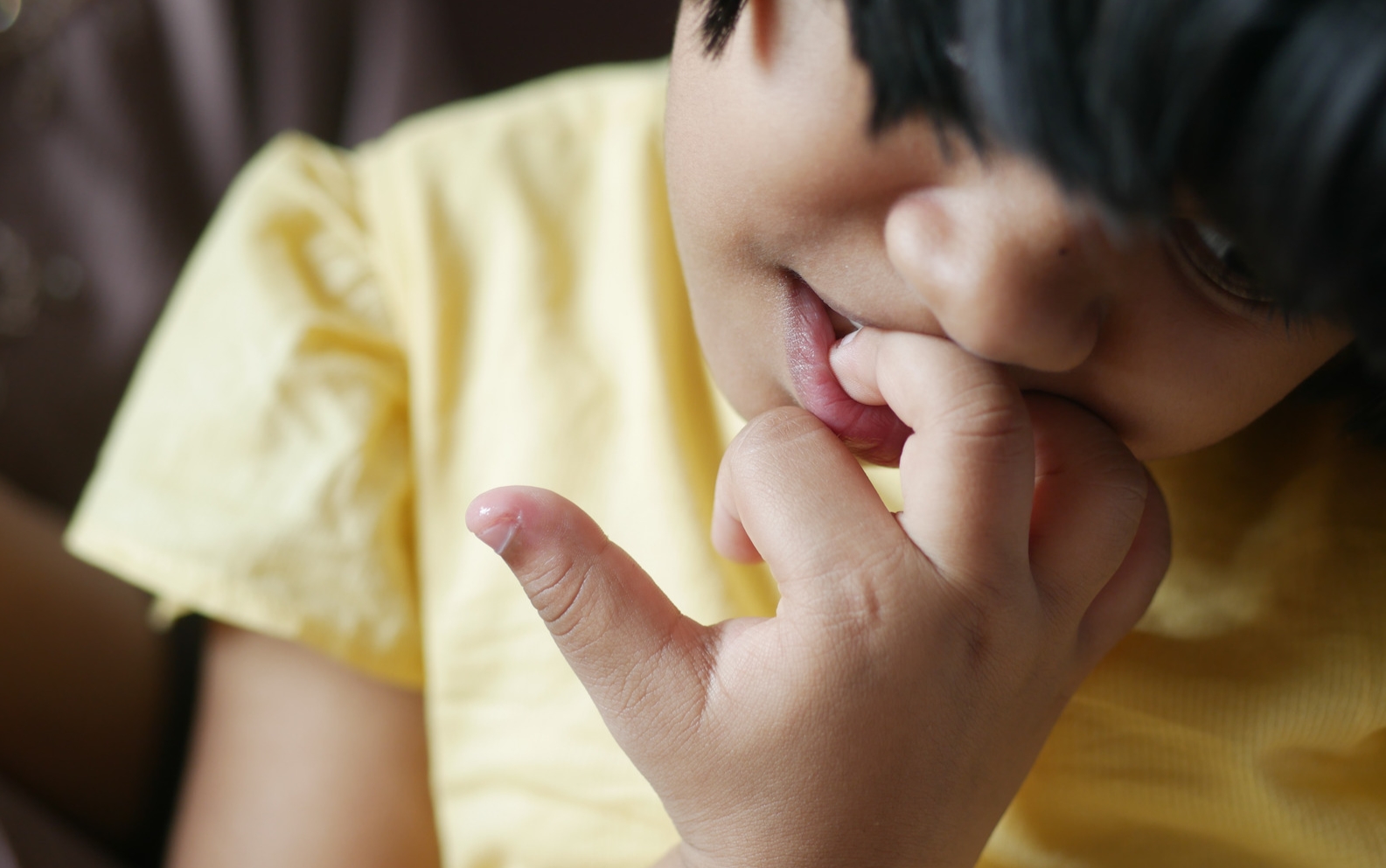Mouthing behavior, which involves placing non-food objects into the mouth, is a common occurrence in children with Autism Spectrum Disorder (ASD). While mouthing is typically seen in early childhood as part of sensory exploration, it can persist in children with developmental delays, including those with autism.
Understanding the causes and impact of mouthing behavior is crucial for parents and caregivers to effectively manage this behavior. Here, we’re going to look at its causes and how to stop it.

Causes of Mouthing Behavior
Mouthing in autism may serve multiple functions, such as exploring the environment, self-soothing during periods of anger or stress, or responding to sensory needs. It is important to recognize that each child with autism is unique, and the underlying reasons for their mouthing behavior may vary. By identifying the specific causes, parents and caregivers can tailor interventions to address the individual needs of the child.
Impact of Mouthing on Children
Mouthing behavior can have various impacts on children with autism. These impacts may include safety risks and hygiene concerns. Placing non-food objects in the mouth can lead to choking hazards or ingestion of harmful substances. Additionally, excessive mouthing can affect dental health and cause damage to objects or clothing.
Managing mouthing behavior is crucial not only for the child’s safety and well-being but also for promoting their overall development and quality of life.
By implementing appropriate strategies and interventions, parents and caregivers can help reduce mouthing behavior and support the child’s sensory exploration and self-regulation in a safe and controlled manner.
How to Address Mouthing Behavior
Fortunately, there are various strategies that can be employed to promote appropriate chewing and provide alternative sensory input. By understanding these strategies, parents and caregivers can help reduce mouthing behavior and ensure the safety and well-being of their loved ones.
Safe Alternatives for Chewing
Chewing throughout the day can help individuals with sensory needs and/or autism calm, focus, and self-regulate, especially during times of stress and anxiety. Providing a safe alternative for chewing can redirect their need for oral sensory input and prevent them from chewing on inappropriate objects, reducing the risk of injury or exposure to harmful substances.
One effective approach is to utilize chewable jewelry or chew tools specifically designed for this purpose. Chewable jewelry, such as necklaces or bracelets, are made from safe materials that can withstand chewing.
Chew tools like the Grabber and Y-Chew offer a variety of textures and shapes to cater to individual preferences.
Sensory Diet and Proprioceptive Input
Following a sensory diet, which involves providing the right amount of proprioceptive input throughout the day, can help decrease the need to chew. Proprioceptive input refers to the deep pressure and joint compression that can be achieved through activities like heavy lifting, pushing, or pulling.

Some examples of proprioceptive activities include carrying heavy objects, engaging in resistance exercises, or using therapy balls for rolling and squeezing.
Oral Sensory Activities
Incorporating other oral activities into the daily routine can keep the mouth busy and provide oral sensory feedback, thereby reducing the need to chew on inappropriate objects.
These activities can range from simple exercises to more structured interventions.
One such activity is gum massage, where gentle pressure is applied to the gums using a clean finger or a soft-bristled brush. This provides oral input in a different way and can help decrease the need to chew. Offering harder-to-chew foods, such as crunchy vegetables or fruits, can also provide oral stimulation and satisfy the sensory needs of individuals with autism.
Additionally, incorporating activities like blowing through whistles or drinking through straws can engage the mouth and provide oral sensory feedback without resorting to inappropriate chewing behaviors.

Identify Triggers and Patterns
A crucial step in managing mouthing behavior among autistic individuals is identifying the triggers and patterns that may be contributing to this behavior.
By closely observing the individual, parents and caregivers can gain insight into what situations or stimuli may be causing the excessive mouthing. It could be related to anxiety, sensory needs, or even boredom. Keeping a detailed record of the behavior and accompanying circumstances can help identify these triggers.
Once the triggers are identified, efforts can be made to minimize or modify them. For example, if certain textures or tastes trigger the mouthing behavior, providing alternative sensory activities or offering different foods can help redirect the individual’s focus away from mouthing.
Consult with Professionals
Seeking guidance from professionals who specialize in autism can provide valuable insights and strategies for managing mouthing behavior. These professionals, such as occupational therapists or behavior analysts, can conduct assessments to determine the underlying causes of the behavior and provide targeted interventions.
Collaborating with professionals also allows for a comprehensive approach to addressing the behavior. They can provide individualized strategies, recommend appropriate tools or techniques, and guide parents and caregivers in implementing effective interventions.
Implement a Sensory Diet
A sensory diet involves incorporating specific sensory activities throughout the day to meet an individual’s sensory needs. Following a sensory diet can help decrease the need for mouthing behavior by providing the right amount of proprioceptive input and sensory stimulation.
Activities that provide deep pressure, such as jumping on a trampoline or using weighted blankets, can help regulate the sensory system and reduce the need for mouthing. Gum massage or providing harder-to-chew foods can also provide oral input in a different way, decreasing the urge to chew on inappropriate objects.
It’s important to work with professionals when designing and implementing a sensory diet to ensure it is tailored to the individual’s unique needs and preferences.

Ayurvedic Approaches for Mouthing
Incorporating Ayurvedic approaches can also provide valuable support for addressing mouthing behaviors in individuals with autism. Ayurveda, which is an ancient Indian holistic healing system, focuses on achieving balance in mind, body, and spirit.
Here are some Ayurvedic approaches that may indirectly help manage mouthing behaviors:
Balanced Diet and Dosha
One of the key principles of Ayurveda is the importance of a balanced diet tailored to an individual’s dosha, or constitution. In the case of individuals with autism, incorporating a balanced diet that specifically addresses their dosha can aid in overall sensory regulation.
Foods that balance Vata, responsible for movement and nervous system functions, can be particularly beneficial. Including warm, grounding foods like cooked grains, root vegetables, and nourishing soups can help promote a sense of stability and calmness.
Herbal Remedies and Calming Properties
Ayurveda utilizes various herbal remedies, some of which may have calming properties that can help soothe the nervous system and decrease the need for sensory-seeking behaviors like mouthing.
Two examples of such herbs are Brahmi and Ashwagandha.
Brahmi, also known as Bacopa monnieri, is known for its potential to support cognitive function and reduce anxiety. Ashwagandha, or Withania somnifera, is an adaptogenic herb that may promote relaxation and overall well-being. These herbal remedies can be taken in consultation with an Ayurvedic practitioner or healthcare professional.

Yoga and Guided Meditation
Simple yoga exercises and guided meditation can be valuable tools for individuals with autism to improve self-regulation and reduce behaviors driven by sensory seeking. Yoga poses that focus on grounding and calming, such as forward bends and gentle twists, can help promote a sense of balance and tranquility.
Guided meditation practices, tailored to the individual’s needs and abilities, can also aid in relaxation and self-awareness. Breathing exercises and visualization techniques may be incorporated to encourage a peaceful state of mind.
By implementing these practical strategies, parents and caregivers can help reduce mouthing behavior in individuals with autism. It’s important to remember that each individual is unique, and what works for one person may not work for another.
Consulting with professionals, such as pediatricians, dentists, speech therapists, occupational therapists, and behavioral psychologists, can provide valuable insights and guidance tailored to the specific needs of the individual.
Research continues to shed light on the neurological basis of sensory issues in autism, offering hope for more targeted and effective therapies in the future. By recognizing and addressing sensory processing difficulties, we can improve the quality of life for individuals with autism and their families. If you’re seeking specialized ABA therapy in New Jersey, Indiana, Georgia, and New York, Golden Care offers comprehensive services tailored to meet the unique needs of each individual. Contact us to learn more or book a consultation today.
Sources:
https://jewelautismcentre.com/jewel_blog/tips-for-to-reduce-oral-seeking-behavior
https://psychcentral.com/autism/oral-fixation-autism
https://sanjeevanam.com/blog/how-to-stop-mouthing-in-autism
https://speechblubs.com/blog/5-management-tips-for-oral-stimming
https://www.arktherapeutic.com/blog/10-tips-for-kids-who-need-to-chew-an-oral-sensory-diet



